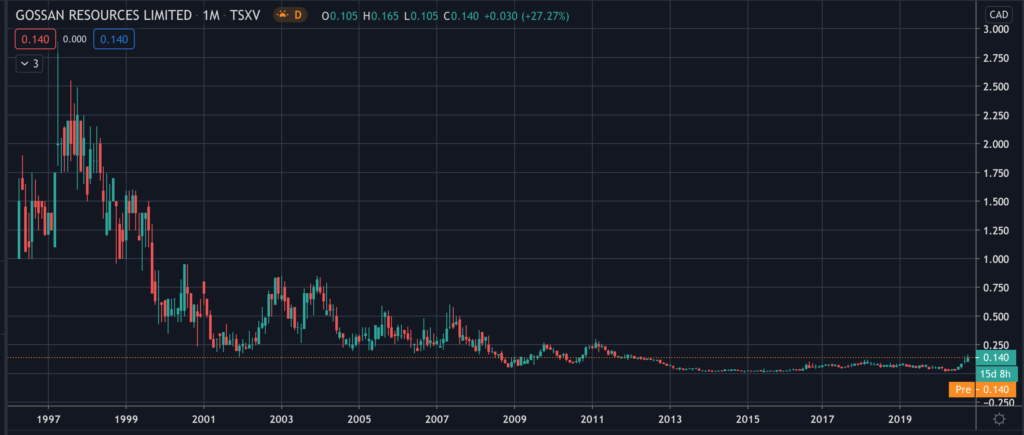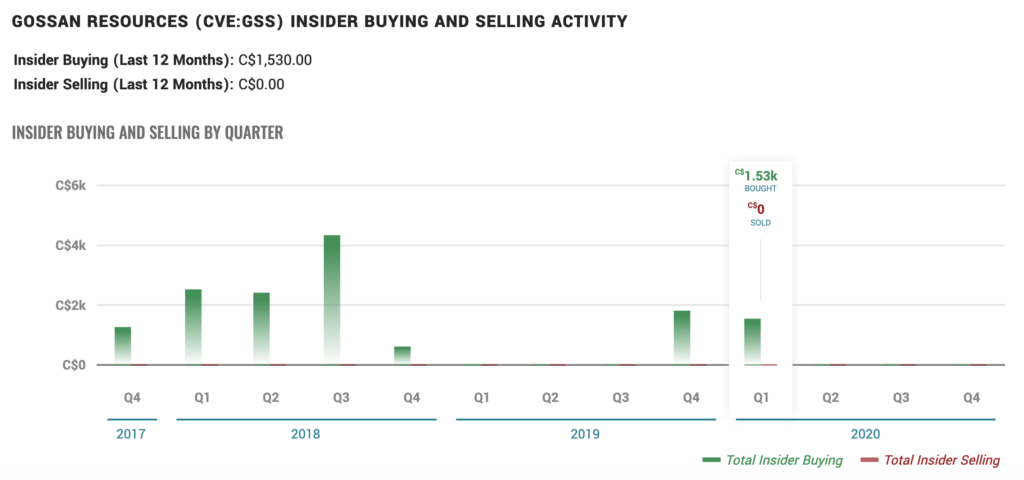Common Stock: Gossan Resources (TSXV:GSS)
Current Market Price: $0.14 CAD
Market Capitalization: $4.7 million CAD
**Note: All values in this article are expressed in Canadian Dollars (CAD) unless otherwise noted.

Gossan Resources Stock – Summary of the Company
Gossan Resources is a mineral exploration company focused on the acquisition, exploration, and development of mineral properties in Canada. The company was founded in 1980 and is headquartered in Winnipeg Canada.
Revenue and Cost Analysis
Gossan does not have any properties that are currently producing and therefore does not have any revenue. The company consistently runs a net loss and is likely to continue to do so for the foreseeable future.
For the fiscal year ending March 2020, Gossan had a net loss of $178 thousand, less that their net loss of $292 thousand in 2018. This decrease is due to lower exploration expense in 2019. The company’s largest expenses are general and administrative followed by exploration expenses.
Balance Sheet Analysis
Gossan has a weak balance sheet. Liquidity is poor and they will need to raise capital in order to continue as a going concern.
Gossan Resources – Debt Analysis
As of the fiscal year end March 2020, Gossan does not have any debt outstanding.
Gossan Resources Stock – Share Dynamics and Capital Structure
As of March 2020 Gossan has 33.8 million shares outstanding. In addition they have 1.6 million options outstanding. Fully diluted shares outstanding is around 35.4 million shares.
Gossan Resources Stock – Dividends
The company does not pay a dividend and is unlikely to do so for the foreseeable future.
Management – Skin in the game
Insiders at Gossan Resources have not made any relevant transactions in the company’s stock recently, providing no signal to investors.

Gossan Resources Stock – 2 Metrics to Consider
Debt to Equity Ratio
Total Liabilities/Total Share Holder Equity
$254 thousand / -$167 thousand = -1.5
A debt to equity ratio of negative 1.5 indicates that Gossan has accumulated losses and has significantly more liabilities than shareholder equity. The company faces the possibility of insolvency and investors should carefully analyze the company’s liabilities before investing.
Working Capital Ratio
Current Assets/Current Liabilities
$87 thousand / $ 254 thousand = .34
A working capital ratio of .34 indicates a weak liquidity position. Gossan may have problems meeting their near term obligations if they are unable to raise capital.
Gold Market – Economic Factors and Competitive Landscape
Gold mining is a highly competitive, capital intensive business. The company will need to compete fiercely for both new projects and capital. However, given the current economic environment of global money printing and zero or negative interest rates, it would appear gold companies are poised to benefit from a strong economic tailwind.
Gossan Resources Stock – Summary and Conclusions
Gossan is in too weak a position financially to be considered investable. In addition to its poor financials, I don’t see anything exceptional about the company’s lightly explored properties that would make the company worth taking a chance on. I would much prefer to allocate to more promising and well-funded exploration companies, such as O3 Mining.
Disclaimer
This is not investment advice. Nothing in this analysis should be construed as a recommendation to buy, sell, or otherwise take action related to the security discussed. If I own a position in the security discussed, I will clearly state it.
This is not intended to be a comprehensive analysis and you should not make an investment decision based solely on the information in this analysis. I hope this serves as a useful starting point for a more comprehensive analysis, and hopefully draws attention to aspects of the company that were overlooked or merit further investigation. This is by no means intended to be a complete analysis. Again, this is not investment advice, do your own research.